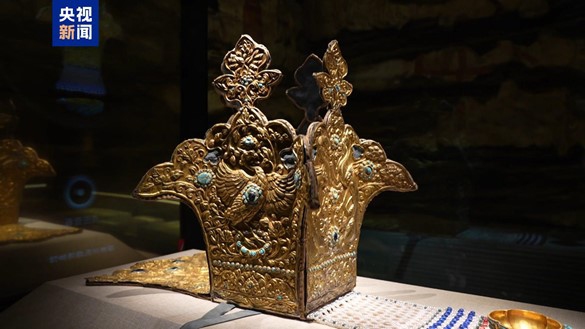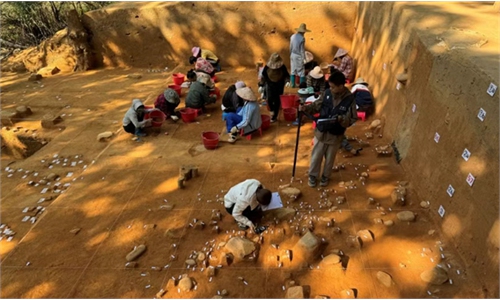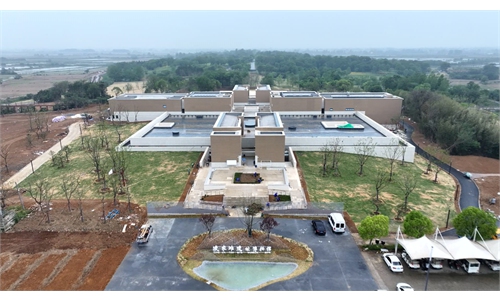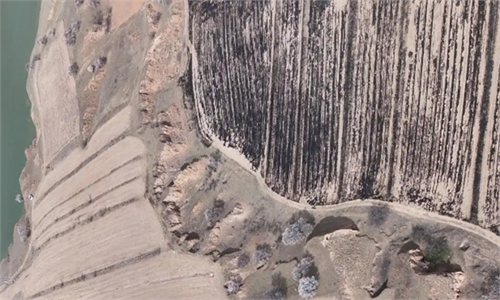China unveils millennium-old crown restoration among 7 major tech archaeology achievements on cultural heritage conservation

Chinese archaeologists successfully restore a crown from the Tubo period with silver and adorned with dragons, phoenixes and lions unearthed from a tomb in Wulan county, Northwest China's Qinghai Province in 2019. Photo: CCTV News
The Chinese Academy of Social Sciences (CASS) unveiled seven major breakthroughs in technological archaeology and cultural heritage conservation in Beijing on Tuesday, highlighting how the integration of traditional techniques and modern science is advancing the preservation and understanding of China's ancient past.Among the standout achievements is the full restoration of a gold crown inlaid with silver and adorned with dragons, phoenixes and lions.
Unearthed in 2019 from a tomb in Wulan county of Northwest China's Qinghai Province, the badly corroded crown, dating back over 1,000 years, was discovered in a hidden chamber that prevented it from grave robbers.
Due to centuries of underground corrosion, archaeologists described it as "shattered beyond recognition."
Huang Xi, a specialist at the CASS laboratory for cultural relic conservation, told the Global Times that the crown's metal base had deteriorated to just under 200 microns in thickness, about the same as three sheets of A4 paper, and broke apart at the slightest touch. The pearls that once formed a decorative drapery across the forehead had scattered like grains of sand.
"After nearly two years of restoration by using domestically patented techniques, we reinforced the silver base and completed more than 10,000 precision micro-welds. X-ray and neutron imaging allowed them to map and reconstruct the complex structure of the crown, including its 2,582 pearl beads," Huang said.
This also marks China's first successful full restoration of a crown from the Tubo period (618-842) with such an intricate design. The recovered motifs speak volumes about cultural exchange: Dragon and pearl elements reflect influences from China's Central Plains, while the twin lions and standing phoenix echo Central Asian aesthetics, highlighting Qinghai's role as a vital hub on the ancient Plateau Silk Road.
Another major development comes from a joint China-Uzbekistan excavation at the Mingtepa site in Uzbekistan, a key project under the Belt and Road Initiative.
In 2024, the China-Uzbekistan joint archaeological team excavated the Mingtepa site. Han Huarui, a member of the Belt and Road joint laboratory for technological archaeology, told the Global Times that the site included multiple collective burials that had been eroded by water, causing the upper layers of relics to scatter and deteriorate, making both identification and preservation extremely challenging at the time.
As a result, the lab team traveled to the site in early 2025 and reassembled equipment from their Beijing lab to set up a mobile conservation laboratory on location.
"Using 3D scanning and hyperspectral imaging technologies, we were able to capture the complex stratified information within the tomb. During the process, we discovered a bronze coin inscribed with the characters 'Wu Zhu' and a Han-style bronze mirror engraved with linked-arc patterns. Notably, we also identified fragments of twill-patterned silk fabric, which may push back the known history of this weaving technique by another century," Han said.
It is worth noting that the bronze coin was worn by the tomb's occupant as an ornament, indicating that its function had gone beyond currency, and the central knob on the back of the round mirror bears elements of Han-style culture, showing that such cultural features had been accepted locally and integrated with indigenous traditions.
Other discoveries unveiled at the conference further deepened understanding of early Chinese civilization and its wide-reaching connections, including evidence of population mixing in Eastern Zhou-era Inner Mongolia, a millennia-long history of indigenous grape use, Mediterranean glass beads indicating pre-Silk Road exchanges and early long-distance copper transport linked to the centralized governance at the Erlitou site.



